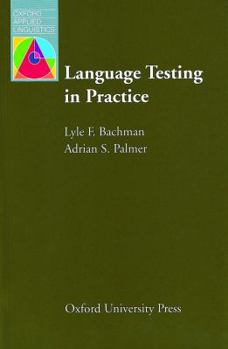Language Testing in Practice: Designing and Developing Useful Language Tests
(Part of the Oxford Applied Linguistics Series)
The practice of testing is related here to views on communicative language teaching and testing. The book is divided into three sections: "Conceptual Bases on Language Testing," "Designing and Constructing Useful Language Tests," and "Collecting, Analyzing, and Using Information from Language Tests."
Format:Paperback
Language:English
ISBN:0194371484
ISBN13:9780194371483
Release Date:September 1996
Publisher:Oxford University Press, USA
Length:384 Pages
Weight:1.30 lbs.
Dimensions:0.8" x 6.2" x 9.3"
Customer Reviews
2 ratings
Teaching Resource
Published by Thriftbooks.com User , 15 years ago
This book isn't really a how-to-guide in the sense that it gives you one method to build a "perfect" test (which does not exist). The text does give you ways to think about what kind of information you want from a test, how to structure effective tests, how to use the information from proctoring the test, and so forth. I find this text to be a great resource for teachers both new and experienced. The text shows great examples of the process of building useful tests in a language learning situation. Examples come from the authors' experiences as well as from others they have reviewed.
Test development concepts and procedures for the real world
Published by Thriftbooks.com User , 23 years ago
Bachman and Palmer have targeted this book halfway between theory and practice, with an audience whose interests are practical but not limited to classroom testing. The book is divided into three parts: the first is concerned with presenting their model of testing theory, the second provides a step by step account of how to develop tests for real life contexts and the classroom, and the third provides ten case studies of different kinds of tests, worked out in greater or lesser detail according to the model they present earlier. The book is therefore useful for students beyond a practically oriented teacher training level, and is suitable to introduce the concept of test development as a team effort, a project planned and managed by a team leader. At the same time, it is simple enough for those on applied linguistics or language teacher education courses who do not have the time or interest to pursue theoretical issues in detail. It presents one model, that of the authors, which draws a great deal on Bachman (1990) Fundamental considerations in language testing. It does not compare or evaluate different models in the way McNamara (1996) does. All of this makes the book accessible and useful, hence its popularity in the sales figures. The emphasis they place on keeping an eye of the context of situation and an analysis of language use and related factors as the basis for test design are very useful and sound. Also, the procedures given for developing tests are easy enough to follow. However, the book has at least a couple of things that might make it a bit difficult to follow, at least until you get used to it. For a start, the language used by the authors tends to be a bit dry and abstract. For example, for they call the planning stage of test development `design', the writing stage `operationalization' and the use and review stage `administration'. They use the abbreviation TLU for target language use situation, a way of referring more or less to the sociolinguistic concept of context of situation. The use of terms like `channel', `form', `language' and `type' in the section on the communicative context may be a bit abstract for some. Despite the many examples of real situations used to illustrate their concepts throughout the book, the writing remains uninspiring, and it might have been better to use more colloquial language, a la Steven Pinker or Jean Aitchison. In addition, the structure or organization of the book with its three sections requires that some ideas are presented not in one section, but are found in smaller bits throughout the book. For example, the material on `quality control' for tests, the plan for the evaluation of usefulness, is split between the theoretical coverage in section one, the actual `how to do it' in section two, and the various case studies in section three. Overall, however, I found their approach sound, and the book is certainly a very useful one. I would recommend its use in undergraduate and postgraduate c





